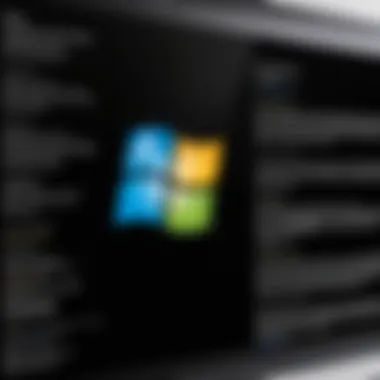Downloading Python for Windows: A Complete Guide


Intro
Python has grown significantly in popularity since its inception. Understanding how to download it on Windows is the first step towards unlocking its capabilities. This process is vital for students and anyone beginning their programming journey. The subsequent sections delve into what Python offers and how to navigate its installation seamlessly.
Foreword to Programming Language
Python, created by Guido van Rossum, made its debut in the late 1980s. It is designed for code readability and succinctness. Over the years, its versatility has made it a preferred choice for web development, data analysis, artificial intelligence, and scientific computing.
History and Background
Python's philosophy emphasizes code clarity, which makes it preferable among newcomers. Its development has resulted in multiple versions, with Python 3 being the current standard. The community around Python is vast, contributing to a rich ecosystem of libraries and frameworks.
Features and Uses
Several features highlight Python's appeal:
- Ease of Learning: The syntax is straightforward, making it accessible for beginners.
- Extensive Libraries: Python has a comprehensive standard library that simplifies complex tasks.
- Cross-Platform Compatibility: Python works well across various operating systems, including Windows, macOS, and Linux.
These characteristics render Python effective for diverse applications, ranging from simple scripts to complex data processing.
Popularity and Scope
In recent years, Python's popularity has surged, especially in educational settings. Data from sources like Wikipedia) indicate that it frequently ranks among the top programming languages globally. Its use in fields such as machine learning and data visualization contributes to its widespread recognition.
Basic Syntax and Concepts
Familiarity with Python's syntax and foundational concepts is essential for effective programming.
Variables and Data Types
Variables are fundamental in Python. They store data values. Common data types include integers, floats, strings, and booleans. The syntax for creating variables is straightforward:
Operators and Expressions
Python supports various operators for performing computations, including:
- Arithmetic Operators: Such as +, -, *, and /.
- Comparison Operators: Like ==, !=, , and >.
These operators enable developers to build logical expressions easily.
Control Structures
Control structures dictate the flow of the program's execution. Key elements include if-else statements and loops such as for and while. For example:
Advanced Topics
Once the basics are mastered, exploring advanced subjects can enhance programming skills.
Functions and Methods
Functions organize code into reusable blocks. Defining a function is simple:
Object-Oriented Programming
Python supports object-oriented programming, utilizing classes and objects. This promotes code reusability and modularization.
Exception Handling
Errors are inevitable in programming. Python employs try-except blocks to gracefully handle exceptions, allowing programs to continue functioning in the presence of errors.
Hands-On Examples
Applying knowledge through practice reinforces learning.
Simple Programs
Start with simple tasks, like creating a program that prints numbers from 1 to 10.
Intermediate Projects
Develop more complex applications, like a calculator that performs basic arithmetic operations. Such projects can challenge your understanding while solidifying your skills.
Code Snippets
Referencing code snippets can streamline projects. Websites like Reddit often provide helpful examples and discussions.


Resources and Further Learning
Expanding knowledge is crucial in the programming realm. Consider the following resources:
Recommended Books and Tutorials
- Automate the Boring Stuff with Python by Al Sweigart
- Learning Python by Mark Lutz
Online Courses and Platforms
- Coursera
- edX
- Codecademy
Community Forums and Groups
Engaging with communities, such as those found on Facebook or specialized forums, enhances learning. Interaction with experienced programmers provides insights and guidance.
Remember, practice is key to mastery in programming. Spend time writing code and experimenting with projects to significantly improve skills.
Understanding Python and Its Importance
In the realm of programming languages, Python stands out for its versatility and ease of use. Understanding Python and its importance is crucial for those eager to enter the world of programming. This section will underscore why Python is not just a mere tool but a significant asset for developers, data scientists, and educators alike.
Python's design philosophy emphasizes code readability, simplicity, and the use of significant indentation. These characteristics make it an excellent entry point for beginners who may find other languages cumbersome. Moreover, Python's dynamic typing and robust standard library enhance its applicability across various domains, from web development to artificial intelligence.
"Python enables quick development and iteration, making it a preferred choice for startups and tech giants alike."
What is Python?
Python is a high-level, interpreted programming language created by Guido van Rossum and first released in 1991. It supports multiple programming paradigms, including procedural, object-oriented, and functional programming. Its syntax is clear and easy to learn, making it a favored choice for individuals who are just starting their coding journey. The language promotes code reuse and modular programming, which are essential for maintaining large codebases.
The Python Software Foundation maintains Python. This organization ensures that Python remains an open-source language, allowing users to enhance and extend its capabilities. Over the years, Python has gained a substantial user base, drawn by its flexibility and support for various libraries and frameworks.
Applications of Python in Various Domains
Python's applicability stretches across multiple domains, making it a universal tool in the tech industry. Here are a few key areas where Python shines:
- Web Development: Frameworks like Django and Flask facilitate the building of dynamic websites and web applications.
- Data Science and Analytics: Libraries such as Pandas, NumPy, and Matplotlib are powerful for data manipulation and visualization, making Python essential in data-driven decision-making.
- Machine Learning and AI: Python's simplicity and the presence of libraries like TensorFlow and Scikit-learn empower developers to implement complex machine learning models easily.
- Scripting and Automation: Python is often used for scripting to automate mundane tasks, thus improving productivity.
- Game Development: Libraries such as Pygame allow developers to create high-quality games efficiently.
The language's extensive community support means continuous evolution and resource availability. This fosters an environment where learners can find educational materials, share knowledge, and seek assistance effectively.
In summary, understanding Python's importance involves recognizing its multifaceted applications, ease of learning, and the supportive ecosystem that surrounds it. As the demand for skilled programmers continues to rise, mastering Python becomes ever more relevant.
Preparing to Download Python
Before proceeding to download Python, it is essential to understand the groundwork that will facilitate a smooth installation. Preparing adequately not only ensures compatibility but also enhances the overall experience during setup. Key areas to focus on include system requirements and selecting the appropriate version of Python. By doing so, users can mitigate potential issues down the line and streamline their programming journey.
System Requirements for Windows
Understanding the system requirements for Python on Windows is a critical first step. Python needs certain specifications to run efficiently on your computer. This includes operating system version, processor type, memory, and disk space.
- Operating System: Most versions of Python are compatible with Windows 7 and above, including Windows 10. Using an outdated operating system can lead to compatibility issues.
- Processor: A modern processor, such as Intel Core or AMD Ryzen series, is recommended. They ensure that Python and its libraries function optimally.
- Memory: Having at least 2 GB of RAM is advisable. This allows for a more comfortable experience when running code or utilizing complex libraries.
- Disk Space: Ensure that you have at least 1 GB of free disk space for Python and additional libraries.
By meeting these requirements, users will reduce the chances of encountering errors upon installation and can seamlessly run Python programs.
Choosing the Right Python Version
Selecting the appropriate Python version is vital for ensuring compatibility with projects and libraries you intend to use. Python has evolved through many versions, with 3.x being the most recommended. Here are some factors to consider when deciding:
- Latest Release: Generally, downloading the latest stable release is wise. As of now, the version 3.10.x offers numerous features and enhancements.
- Specific Libraries: Some libraries or frameworks may support only certain Python versions. Research will help in selecting a version that accommodates these tools. For example, TensorFlow has specific requirements.
- Long-term Support: If stability is a priority, consider using a version marked for long-term support. This approach is beneficial for production environments where changes can introduce instability.
Keeping these factors in mind assists in making an informed choice, ultimately leading to a more effective programming experience.
Where to Download Python
In the process of acquiring Python, it is crucial to understand where to obtain the software. Downloading from reliable sources ensures that you get a trustworthy and secure installation. This section highlights important considerations about the sources of Python, weighing the merits of official and alternative download options.
Official Python Website Overview
The official Python website, python.org, serves as the primary source for downloading Python. This site is maintained by the Python Software Foundation, which guarantees the latest and most secure versions of the software.
When you visit the official site, you will find a prominent download button, usually showcasing the latest stable version that is compatible with your operating system. This direct access is beneficial for several reasons:
- Security: Downloads from the official website are verified and free from malware. You can trust that what you are installing is the actual software.
- Latest Updates: The official site provides the most recent updates. This can be important for accessing new features and fixes.
- Comprehensive Resources: The site offers extensive documentation, tutorials, and links to community resources, making it a one-stop shop for new users.
In addition, the official site includes checksums for each download. This allows you to confirm the integrity of the downloaded file. Ensuring the file is intact and secure is critical to a smooth installation process. Always opt to download from the official Python website when possible.
Alternative Sources for Downloading
While the official Python website is the most recommended source, there are alternate locations where Python can be downloaded. However, caution is necessary when choosing these other sources. Some may offer outdated or modified versions of Python. Below are some viable alternative sources:
- Anaconda: This is a widely used distribution that comes with Python and many scientific libraries pre-installed. It is especially popular among data scientists and statisticians. Users can download it from anaconda.com.
- Microsoft Store: On Windows, Python is also available in the Microsoft Store. This option allows users to install Python with a single click. It is integrated nicely with the operating system, but may not provide the full flexibility available through the official distributions.
- Chocolatey: For users comfortable with command-line tools, Chocolatey is a package manager for Windows. It allows quick installations and upgrades of Python. Detailed commands are documented on their website, chocolatey.org.
Always verify the integrity and authenticity of downloads from alternative sources.


While these alternative methods can be convenient, ensure to stay informed about the versions being downloaded and their origins. Downloading from improper sites may lead to issues like security vulnerabilities, so a careful approach is essential.
In summary, when acquiring Python, prioritizing the official website is the safest approach. Alternative sources have their advantages, but users should exercise due diligence. Understanding these download options is essential for a successful Python installation.
Step-by-Step Installation Process
The installation of Python on Windows is crucial for anyone looking to delve into programming. A step-by-step guide ensures that users can follow along efficiently, avoiding common pitfalls that may cause frustration. Following this systematic approach not only simplifies the installation but also enhances understanding of each component involved in the process.
The benefits of a clear installation process are numerous. First, it allows users to ensure they have the necessary system requirements before initiating the installation. Secondly, it provides an opportunity to tailor the setup according to individual preferences and programming needs. Also, it helps in diagnosing potential issues during the installation phase that could impact future programming endeavors. Consequently, taking the time to follow these steps can significantly enhance a user’s experience with Python.
Initiating the Installer
To begin the installation of Python on Windows, you first need to access the installer. If you have downloaded it from the official Python website, locate the executable file in your Downloads folder or wherever you chose to save it. Double-clicking the file will launch the installation wizard.
Upon opening, you are usually presented with a dialogue box that outlines the features available during installation. Keep an eye on the options provided here; it is often beneficial to check "Add Python to PATH". This option simplifies launching Python from the command line, making it easier for users to run scripts and commands directly.
Customizing Installation Options
After initiating the installer, you have the option to customize your installation settings. This stage is particularly important for users who have specific needs or preferences.
You will see both standard and advanced options. Among the standard choices are options like upgrading the existing version or selecting a new installation directory. For more advanced users, explore options regarding the inclusion of pip, which is essential for package management in Python. By ensuring pip is included, you will be able to install additional Python packages easily.
Here are some common customization choices:
- Install location: Choose where to install Python.
- Add to PATH: Simplifies access to Python from anywhere in the command line.
- Optional features: Select to install pip, IDLE, or documentation.
Completing the Installation
Once you have customized your installation settings, the next step is to complete the installation. Click the install button, and the installer will begin to write the necessary files to your system. This process should only take a few moments.
During the installation, you might see a progress bar indicating how much of the installation process has been completed. It’s essential to allow this process to finish without interruption. When the installation completes successfully, you will receive a confirmation message.
At this point, you can choose to disable or enable the option to disable the path mode, which can be helpful for many users. After clicking finish, take a moment to verify that Python was installed correctly by opening the command prompt and typing:
A confirmation of the installed Python version indicates a successful installation.
By carefully following these steps, users can ensure that Python is correctly installed on their Windows machine, paving the way for a smooth programming experience.
Verifying Python Installation
Verifying the installation of Python is a crucial step after you've completed the download and installation process. This stage ensures that Python has been integrated properly into your Windows system. Confirmation reduces the likelihood of running into issues later on while executing Python scripts. Knowing Python is installed helps build your confidence as you begin to delve into programming. It also allows you to troubleshoot any unforeseen problems quickly.
Using Command Prompt
To verify that Python is installed, you can use the Command Prompt. This tool is a vital feature in Windows for executing commands. The process begins with opening the Command Prompt. You can find it by typing "cmd" in the Windows search bar. Once open, type the following command and press Enter:
If Python is installed correctly, this command should return the version number of Python you have installed. It is important to make sure you see a valid version number; if you encounter an error message, it could indicate that Python is not installed correctly, or the installation path is not recognized.
Checking Installed Versions
Another useful command is:
This command invokes Python's launcher for Windows, which allows you to check all installed versions of Python without ambiguity. If you’ve installed multiple versions, this command helps identify them easily. If you need to switch between different versions in your projects, knowing how to check installed versions is necessary.
This verification process helps to recognize any path issues or installation mishaps early. Consider these checks as a foundation; they prepare you for further steps in your programming journey. If you encounter difficulties, there are numerous resources available, such as the official Python documentation found at official Python documentation.
Always ensure you verify your installation to avoid problems later in your coding endeavors.
Managing Multiple Python Versions
Managing multiple Python versions on a single machine is an essential topic for those working with Python. Various projects may require specific versions due to compatibility or feature differences. Understanding how to manage these versions helps developers maintain a clean and efficient coding environment.
Understanding the Need for Version Management
When working on different Python projects, you might face situations where one project requires Python 3.7 while another needs Python 3.10. Without a proper management system in place, conflicts arise. Issues such as broken packages or environment instability can lead to wasted time and frustration. Thus, version management is not just a convenience; it's a necessity.
Benefits of Managing Python Versions
- Project Specificity: Maintain compatibility tailored to each project's requirements.
- Smooth Transition: Easily switch between versions when testing or developing.
- Isolation: Protect environments from interfering with one another.
- Capability Handling: Leverage newer features without discarding older projects.
Using Virtual Environments
A practical way to manage multiple Python versions is by creating virtual environments. Virtual environments allow for compartmentalizing environments for individual projects. This ensures that dependencies required for one project do not mess up another.
Creating a Virtual Environment
- Make sure you have Python installed that you wish to use in your new environment.
- Open your command prompt or terminal.
- Navigate to your project directory where you'd like the environment.
- Run:
- Activate the environment:


- On Windows:
- On macOS/Linux:
Once activated, any Python packages you install using pip will be confined to this environment.
Key Considerations
- Each virtual environment can have separate dependencies.
- You can easily deactivate an environment when done.
- It makes it easier to experiment with new packages without affecting other projects.
By employing effective version management techniques and utilizing virtual environments, you can create a robust and flexible Python working framework. This approach empowers both learners and experienced programmers to navigate the complexities of Python development more efficiently.
Setting Up Development Environments
Setting up a suitable development environment is crucial when working with Python. It serves as the foundation for your programming activities, allowing for efficient code writing, testing, and debugging. A well-configured environment can significantly enhance your productivity. There are several aspects to consider when setting up your development space, including the choice of an Integrated Development Environment (IDE), tools for managing libraries, and configuration settings.
One of the principal benefits of establishing a proper development environment is the ease of managing projects and dependencies. Python offers a plethora of libraries and frameworks, and tracking them can become a cumbersome task without the right tools. Additionally, a dedicated environment allows for better organization of files and code, making collaboration with others more seamless. Furthermore, the ability to easily switch between different projects and configurations is an essential feature, particularly for intermediate and advanced users.
Overview of Integrated Development Environments
Integrated Development Environments, or IDEs, are software applications that provide comprehensive facilities to computer programmers for software development. An IDE typically includes a source code editor, build automation tools, and a debugger. In the context of Python development, IDEs offer features such as syntax highlighting, code completion, and integrated terminal access. These functionalities not only streamline coding but also help reduce errors and improve coding efficiency.
Some popular IDEs can be complex and heavy on system resources, but they provide extensive features suited for larger projects. Others may be lightweight, focusing on essential functionality, making them ideal for beginners. Ultimately, selecting the right IDE can enhance the coding experience by providing support tailored to individual needs.
Recommended IDEs for Python
When choosing an IDE for Python, it's essential to consider factors like user experience, feature set, and community support. Here are a few recommended IDEs:
- PyCharm: A powerful IDE developed by JetBrains, PyCharm is feature-rich, offering code analysis, a graphical debugger, and an integrated unit tester. The Community Edition is free, making it accessible for those starting out.
- Visual Studio Code: A popular open-source code editor by Microsoft, Visual Studio Code supports a vast range of extensions, including those specific to Python. It features integrated Git control, ensuring smooth version management.
- Anaconda Navigator: Ideal for data science applications, Anaconda Navigator provides a graphical user interface for managing packages, environments, and launching applications like Jupyter Notebook and Spyder.
- Jupyter Notebook: While technically not a traditional IDE, Jupyter Notebook is widely used in data analysis and research. It allows you to create documents that contain live code, equations, and visualizations, making it suitable for exploratory data analysis.
Choosing the right IDE is subjective and should reflect the user's requirements and preferences. Every programmer should experiment with several options to discover what works best for their style.
"The right tools can elevate the programming experience significantly, making it smoother and more enjoyable."
Common Issues During Installation
Installing Python on Windows, while generally straightforward, can present several challenges. Addressing these common issues is essential for ensuring a successful installation. Understanding potential pitfalls not only saves time but also reduces frustration, allowing users to focus on learning and coding instead of troubleshooting. By being aware of these issues, individuals can anticipate problems and find solutions more efficiently. This segment will guide users through typical hurdles encountered during installation, helping them navigate these challenges seamlessly.
Troubleshooting Installation Problems
Installation problems are not uncommon when downloading and setting up Python on Windows. Various factors can contribute to these issues. For instance, corrupted downloads, incompatible versions, or system errors can all halt the installation process. Here are some of the main concerns and their resolutions:
- Corrupted Installer: If the installer fails, ensure the download is complete and not interrupted. A quick way to check is to compare the file size against the official listing on the Python website.
- Running with Insufficient Privileges: Users often forget to run the installer with administrative rights. Right-click on the installer and select "Run as administrator" to prevent permission issues.
- Antivirus Interference: Sometimes, antivirus software might mistakenly classify the Python installer as a threat. Temporarily disabling such software during installation might help. Make sure to reactivate it afterward.
Resolving installation problems can make a significant difference in the overall experience. Users should maintain patience, as technical hiccups are often solvable with careful troubleshooting.
Resolving Path Issues
A frequent complication arises with path configurations, especially when users have multiple versions of Python installed. The system’s PATH variable plays a crucial role in how Windows locates and runs Python. If not set correctly, users may encounter errors in running Python scripts or commands. Here are some common path-related issues and their solutions:
- PATH Not Set: During installation, ensure the option to add Python to the PATH variable is checked. Failing to do so results in the command prompt being unable to recognize Python commands.
- Conflicting Versions: If multiple versions exist, the command prompt may default to an older version. To resolve this, users can adjust the order in the PATH variable or explicitly call the desired version using its full path.
- Verifying the Configuration: After setting the PATH, using the command in the command prompt can confirm if Python is correctly recognized.
"Correctly setting the PATH variable is critical for successful Python script execution on Windows."
By proactively addressing path issues, users can ensure smooth operation when using and developing Python applications.
Resources for Further Learning
The journey of learning Python does not end with installation. Having access to quality resources is pivotal for anyone wishing to deepen their understanding or hone their skills in Python programming. This section addresses essential resources that can significantly aid your learning process. It includes the Official Python Documentation and various online courses and tutorials that are designed to cater to learners at different levels.
Official Python Documentation
The Official Python Documentation is an indispensable resource for any Python developer. It serves as the primary source of information about Python’s syntax, libraries, and functionalities. Written and maintained by the core Python developers, the documentation is comprehensive and updated with every new release.
Here are some key features:
- In-depth Tutorials: The documentation includes tutorials that guide beginners through the basic concepts of Python. Starting from simple exercises, learners can progress to more complex topics.
- Library Reference: With extensive details on the built-in functions and third-party libraries, it allows users to understand the capabilities of Python without reference to external sources. All standard libraries are documented here.
- Active Community: The documentation is continually improved due to contributions from the community, making sure that it remains relevant and reflective of current best practices.
As one delves into the documentation, it’s advisable to practice the examples provided. This hands-on approach solidifies learning. Also, do not hesitate to explore the FAQs as they often address common concerns and queries.
"A thorough understanding of the documentation empowers programmers to troubleshoot and innovate effectively."
Online Python Courses and Tutorials
In addition to the official documentation, various online platforms provide structured courses and tutorials catering to Python learners. These resources offer diverse formats, from video lectures to text-based instructions. Below are some considerations for utilizing online courses:
- Diversity in Learning Styles: Courses are tailored for different learning styles. Whether you prefer video lectures, hands-on coding challenges, or reading materials, there’s something for everyone.
- Community and Support: Many platforms provide forums or community assistance, allowing learners to ask questions and share knowledge. Engaging with peers can enhance the learning experience.
- Project-Based Learning: Practical applications help in solidifying concepts. Many courses include projects which encourage learners to apply their knowledge in real-world scenarios.
Some of the notable platforms for online learning include:
- Codecademy: Interactive Python courses providing hands-on experience rather than just theory.
- Coursera: Offers Python courses from respected institutions, often culminating in a certificate.
- edX: Provides both free and paid courses with material from universities and professional organizations.
Overall, incorporating these resources into your Python learning strategy will provide a robust foundation and also expand your understanding of the language. As you continue your journey, remember that continuous learning is essential in the world of programming.







